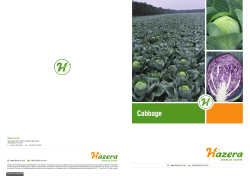
Cabbage Juice Indicator Lab Purpose: To test
Cabbage Juice Indicator Lab Purpose: To test various household substances with a homemade cabbage juice indicator. Materials: red cabbage blender or knife boiling water filter paper (coffee filters work well) one large glass container 6-9 small glass containers or jars household ammonia (NH3) baking soda (sodium bicarbonate, NaHCO3) washing soda (sodium carbonate, Na2CO3) Found in the laundry aisle of your local grocery store, Arm & Hammer is a common brand. lemon juice (citric acid, C6H8O7) vinegar (acetic acid, CH3COOH) cream of tartar (potassium bitartrate, KHC4H4O6) antacids (calcium carbonate, calcium hydroxide, magnesium hydroxide) seltzer water (carbonic acid, H2CO3) drain cleaner if available (be careful, this is caustic and will burn your skin) Procedure 1. Chop the cabbage into small pieces until you have about 2 cups of chopped cabbage. Place the cabbage in a large glass container and add boiling water to cover the cabbage. Allow at least ten minutes for the color to leach out of the cabbage. (Alternatively, you can place about 2 cups of cabbage in a blender, cover it with boiling water, and blend it.) 2. Filter out the plant material using the coffee filter to obtain a red-purple-bluish colored liquid. This liquid is at about pH 7. (The exact color you get depends on the pH of the water.) 3. Pour about 50 - 100 mL of your red cabbage indicator into each 250 mL glass container. Note: 1 US cup = 236.588237 mL For purposes of this lab, where precise volumes are not required, we can round 1 cup to 250 mL. So, pour approximately ¼ cup of your red cabbage indicator into each 1 cup container. 4. Add various household solutions to your indicator until a color change is obtained. Use separate containers for each household solution - you don't want to mix chemicals that don't go well together! There are nine substances listed, you must test at least six to receive full credit. You may substitute the items listed for other substances if you send the list of substances you want to test to your instructor for approval first. The color chart for the cabbage juice indicator is as follows: pH 2 4 6 8 10 Color Red Purple Violet Blue Blue-Green Record your observations in the data table below. 12 Greenish Yellow Household Substance Observations Approximate pH Acid, Base, or Neutral substance? Notes: Chemicals used in this demo may be safely washed down the drain with water. You can make your own pH paper strips using red cabbage indicator. Take filter paper (or a coffee filter) and soak it in a concentrated red cabbage juice solution. After a few hours, remove the paper and allow it to dry (hang it by a clothespin or string). Cut the filter into strips and use them to test the pH of various solutions. Write the lab report using the lab report format outlined earlier in the course. Submit the lab report to the dropbox labeled Cabbage Juice Indicator Lab found in Module 11. Rubric: Data Table: You are required to test at least 6 substances. For each of those 6 substances, there are 3 columns of the data table to be filled in, for a total of 18 items. Each piece of data is worth up to 3 points for a total of 54 points. 3 points awarded if data is present and values are correct. Observations are detailed and offer vivid descriptions. 2 points awarded if data is present, but observations are not detailed. 0 points awarded if no data is present. Lab Writeup Format: 10 points are awarded for lab being in proper lab writeup format. For each error in the writeup format, 1 point will be subtracted. from http://cms.gavirtualschool.org/Shared/Science/Chemistry/acids_bases_shared/acids_bases_shared7.html
© Copyright 2025










